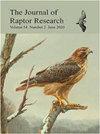Food Habits of the Mountain Hawk-Eagle (Nisaetus nipalensis orientalis) During the Nesting Period in Japan
IF 1.2
4区 生物学
Q2 ORNITHOLOGY
引用次数: 0
Abstract
ABSTRACT. The Mountain Hawk Eagle (Nisaetus nipalensis orientalis) is classified as endangered in Japan and poorly studied throughout its range. We assessed prey fed to a nestling between hatching and fledging (16 April to 31 July) in central Japan. We used a time lapse camera to record prey deliveries and facilitate prey identification, and we estimated prey biomass and energy content across the nesting season. Of 140 prey items delivered to the single nestling, 65 (46.4%) were of five species of snake, 50 (35.7%) were of nine species of birds, 24 (17.1%) were of seven species of mammals, and one was unknown. The diurnal feeding rhythm showed a peak in prey deliveries at midday; all three classes of prey were delivered at various times of the day in a balanced manner. Snakes were especially prominent in the early stages of the brooding period, but diet shifted toward young birds and mammals in the latter half of the season when the prey species' young had become independent of their parents. Snakes made up the greatest percentage of biomass delivered, followed by mammals and then birds. However, mammals provided more energy per g of prey mass than birds and snakes. The adult eagles relied on large snakes awakened from hibernation in early spring, when prey was scarce, and then shifted to mammals with higher energy value during the peak growth period of the eaglet. An additional 233 prey remains collected from 31 other Mountain Hawk-Eagle nests comprised 20 species of birds and 10 species of mammals, and several unidentified snakes. Pooling results, we identified five species of snakes, 24 species of birds, and 14 species of mammals. These results add to the knowledge of the hawk-eagle's diet and will help to inform management of the species. RESUMEN. En Japón, Nisaetus nipalensis orientalis está clasificada como en peligro de extinción y ha sido relativamente poco estudiada en toda su área de distribución. Evaluamos las presas con que alimentaron a un polluelo entre la eclosión y el emplumamiento (16 de abril al 31 de julio) en el centro de Japón. Usamos una cámara rápida (time lapse) para registrar las entregas de presas y facilitar su identificación, y estimamos la biomasa y el contenido de energía de las presas durante la temporada de anidación. De las 140 presas entregadas a un solo polluelo, 65 (46.4%) pertenecieron a cinco especies de serpientes, 50 (35.7%) a nueve especies de aves, 24 (17.1%) a siete especies de mamíferos y una no fue identificada. El ritmo de alimentación diurno mostró un pico en las entregas de presas al mediodía; las tres clases de presas se entregaron en varios momentos del día de manera balanceada. Las serpientes fueron especialmente prominentes en las primeras etapas del período de cría, pero la dieta se desplazó hacia las aves jóvenes y los mamíferos en la segunda mitad de la temporada, cuando los juveniles de las especies presa se independizaron de sus progenitores. Las serpientes constituyeron el mayor porcentaje de biomasa entregada, seguidas por los mamíferos y luego las aves. Sin embargo, los mamíferos proporcionaron más energía por gramo de masa de presa que las aves y las serpientes. Las águilas adultas dependieron de serpientes grandes que despertaban de la hibernación a principios de la primavera, cuando las presas fueron escasas, y luego cambiaron a mamíferos con mayor valor energético durante el período de crecimiento máximo del aguilucho. Otros 233 restos de presas recolectados de 31 nidos adicionales de N. n. orientalis representaron 20 especies de aves y 10 especies de mamíferos, y varias serpientes no identificadas. Combinando los resultados, identificamos cinco especies de serpientes, 24 especies de aves y 14 especies de mamíferos. Estos resultados se suman al conocimiento de la dieta de N. n. orientalis y ayudarán a mejorar el manejo de la especie. [Traducción del equipo editorial]日本山鹰(Nisaetus nipalensis orientalis)在筑巢期的饮食习惯
摘要山鹰鹰(Nisaetus nipalensis orientalis)在日本被列为濒危物种,对其分布范围的研究很少。我们评估了日本中部雏鸟在孵化和羽化之间(4月16日至7月31日)喂养的猎物。我们使用延时摄像机来记录猎物的交付和方便猎物的识别,我们估计了整个筑巢季节猎物的生物量和能量含量。其中,5种蛇类65件(46.4%),9种鸟类50件(35.7%),7种哺乳动物24件(17.1%),1件未知。白天的进食节奏显示,中午是猎物交付的高峰;这三种类型的猎物都在一天中的不同时间以平衡的方式被运送。在孵化期的早期阶段,蛇的作用尤为突出,但在繁殖季的后半段,当被捕食物种的幼鸟已经独立于它们的父母时,它们的饮食转向了年幼的鸟类和哺乳动物。蛇类所占的生物量比例最大,其次是哺乳动物,然后是鸟类。然而,哺乳动物比鸟类和蛇提供更多的能量。成鸟以早春时节从冬眠中醒来的大型蛇类为食,在幼鹰生长高峰期以能值较高的哺乳动物为食。另外,从其他31个山鹰巢中收集到的233具猎物遗骸包括20种鸟类和10种哺乳动物,以及几条身份不明的蛇。结果发现蛇类5种,鸟类24种,哺乳动物14种。这些结果增加了对鹰的饮食的了解,并将有助于为该物种的管理提供信息。RESUMEN。En Japón, Nisaetus nipalensis orientalis estestclassificada como En peligro de extinción y . sido relativamente poco estudiada En toda su área de distribución。1 .对污染中心(eclosión)和污染中心(Japón)(4月16日至7月31日)进行评估。Usamos una cámara rápida(时间延迟)para registrar las entregas de presas y facilitsu identificación, y estimamos la biomasa y el contenido de energía de presas durante la temporada de anidación。共发现140种单一污染,5种蛇类65种(46.4%),5种蛇类50种(35.7%),6种蛇类24种(17.1%)。El ritmo de alimentación diurno mostró un pico en enregas de presas al mediodía;这三种类型的压力和压力与不同时刻的压力和压力的平衡有关。Las serpientes fueron especientes enlas primeras etapas período de cría, pero la dieta se desplazó haacia Las aves jóvenes y los mamíferos en la secunda mitad de la temporada, cuando los juveniles de Las species presa se independdizaron de sus progenores。Las serpientes constituyeron el mayor porcentaje de biomasa entregada, seguidas穷人mamíferos y luego Las aves。在禁运期间,los mamíferos proporcionaron más energía por gramo de masa de presa que las serpientes。拉·阿古里亚·adultas dependieron de serpientes大despertaban de la hibernacion principios de la白桃花心木,cuando Las声部进入记号fueron escasas,采纳cambiaron mamiferos反对市长英勇energetico杜兰特el periodo de crecimiento maximo del aguilucho。共发现31种东方蛇,代表20种东方蛇和10种东方蛇。综合分析结果,鉴定出5种蛇属、24种蛇属、14种mamíferos属。Estos resulttados使用human al conocimiento de la dieta de n.n.orientalis通过ayudarán a mejorar el manejo de la especie。[Traducción del equipo社论]
本文章由计算机程序翻译,如有差异,请以英文原文为准。
求助全文
约1分钟内获得全文
求助全文
来源期刊

Journal of Raptor Research
生物-鸟类学
CiteScore
2.30
自引率
17.60%
发文量
61
审稿时长
>12 weeks
期刊介绍:
The Journal of Raptor Research (JRR) is an international scientific journal dedicated entirely to the dissemination of information about birds of prey. Established in 1967, JRR has published peer-reviewed research on raptor ecology, behavior, life history, conservation, and techniques. JRR is available quarterly to members in electronic and paper format.
 求助内容:
求助内容: 应助结果提醒方式:
应助结果提醒方式:


